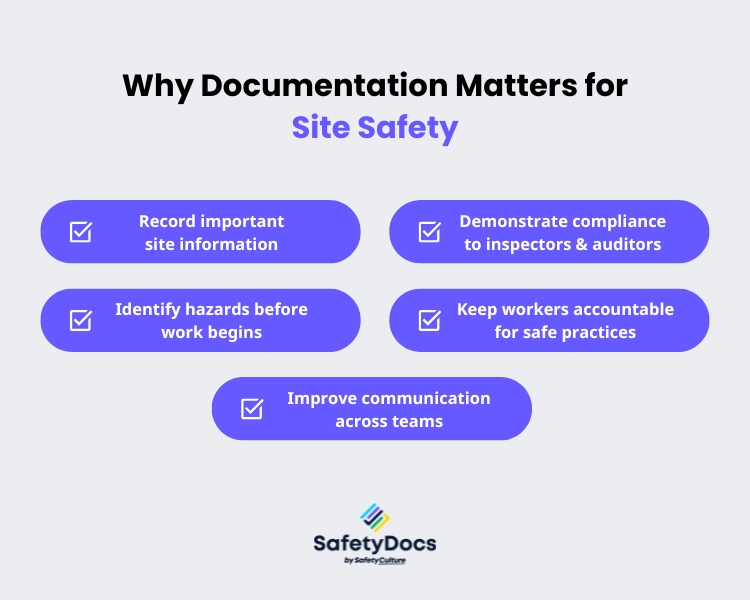Running a safe construction site is about more than PPE and toolbox talks. Clear, consistent documentation keeps jobs on track, hazards under control, and compliance risks off your shoulders.
For supervisors, safety officers, and small-team leads, having the right safety forms in place ensures nothing slips through the cracks. From inductions to incident reports, these documents help you manage risks, communicate with crews, and prove compliance with WHS regulations.
In this guide, we’ll walk through the top 10 safety forms every site supervisor should have, explain why each matters, and show how templates save you time while boosting consistency.
Why Documentation Matters for Site Safety
Construction is high-risk by nature. Heavy machinery, changing site conditions, and multiple contractors working together create plenty of hazards. Safety forms and checklists give you a practical system to:
- Record important site information.
- Identify hazards before work begins.
- Demonstrate compliance to inspectors, auditors, or clients.
- Keep workers accountable for safe practices.
- Improve communication across teams.
Using safety forms helps foster a strong safety culture and supports efficient project management within a construction company, contributing to overall operational success and higher safety standards.
Without reliable WHS documents, even experienced supervisors can miss details that lead to costly incidents or legal consequences.

The Top 10 Safety Forms for Site Supervisors
Here are the must-have documents for safer construction sites, noting the content of each safety form should be tailored to the specifics of the project and site requirements.
1. Daily Pre-Start Checklist
A Daily Pre-Start Checklist ensures equipment, site conditions, and work tasks are reviewed before the day begins. It helps crews identify risks early, making sure hazards are controlled before tools are picked up.
2. Site Induction Form
Before any new worker or contractor steps on site, they should complete a Site Induction Form. This form includes important contact information for safety and emergency support, as well as safety rules and emergency procedures. A signed induction record protects you if regulators or clients check your compliance.
3. Risk Assessment
A Risk Assessment Form breaks down each activity, identifies hazards, and applies control measures. Supervisors use it to determine where extra precautions are required and to prioritise high-risk jobs. It’s the foundation of good WHS management.
4. Safe Work Method Statement (SWMS)
For high-risk construction tasks, a SWMS is legally required. Only activities considered high-risk under WHS regulations require a SWMS. It documents step-by-step how the job will be carried out safely. Procedures and site conditions must be clearly defined in the SWMS. Having the correct SWMS ready to go helps you comply with WHS laws and keeps crews working within safe boundaries. Including detailed site-specifics in each SWMS is essential for effective safety planning and risk assessment.
5. Incident Report Form
Accidents and near misses happen even on well-managed sites. An Incident Report Form records what occurred, who was involved, and what corrective action will follow. These records help prevent repeat issues and demonstrate due diligence.
6. Plant & Equipment Checklist
Construction sites rely on heavy gear. A Plant & Equipment Checklist confirms machinery has been inspected, maintained, and is safe to use. Regular checks reduce breakdowns, downtime, and dangerous equipment failures.
7. Toolbox Talk Record
Toolbox talks are essential for reinforcing safe work practices. A Toolbox Talk Record Form logs the topics covered, attendees, and follow-up actions. Keeping a paper trail shows you’ve actively consulted workers about safety. Toolbox talks also help keep safety top of mind for all workers.
8. Hazard Report Form
Workers need a simple way to flag hazards as they see them. A Hazard Report Form captures these concerns so supervisors can act quickly. Encouraging hazard reporting builds a stronger safety culture and reduces hidden risks.
Hazard reporting is a best practice across many industries, particularly in the construction industry, where tailored checklists and safety protocols address specific risks and hazards.
9. PPE Checklist
From helmets to harnesses, PPE must be checked regularly. A PPE Checklist helps ensure all minimum PPE requirements are met before work begins. It ensures workers have the right equipment for the job, in good condition, and used correctly. It’s a quick but critical step for frontline safety.
10. Contractor Sign-In Sheet
Sites often have multiple contractors coming and going. A Contractor Sign-In Sheet records who’s on site, when they arrived, and whether they’ve completed inductions. The sign-in sheet also tracks sub-contractors (subs) and ensures their compliance with site safety procedures. This supports security, emergency management, and compliance tracking.
Emergency Response Planning
No matter how well risks are managed, emergencies can still happen on construction sites. That’s why having a clear, well-developed emergency response plan is essential for every project. These plans outline the steps workers and other persons should take in the event of an incident, from evacuations to first aid and contacting emergency services.
Effective emergency response planning starts with identifying potential hazards and developing tailored procedures for each scenario. Regular training ensures that everyone on site knows their role and can act quickly if needed. With a solid emergency response plan in place, you can minimise risk, protect health and safety, and ensure a swift, coordinated response when it matters most.
Where to Keep and Store Safety Forms
Forms are only useful if they’re accessible. Best practice is to:
- Keep hard copies in a site office or supervisor’s vehicle.
- Use digital templates stored on tablets or phones for quick access.
- File completed forms systematically, either digitally or in binders, for easy reference during audits or investigations.
Consistency is key. All supervisors should know where to find forms and how to store them after use.
Safety Form Review and Revision
Safety forms are only effective if they’re accurate, up-to-date, and relevant to the work being carried out. That’s why regular review and revision of safety forms is a must for every construction site. This process should involve both safety representatives and workers, ensuring that forms like site induction records and incident reporting documents reflect current site conditions and regulatory requirements.
By reviewing safety forms on a regular basis, companies can identify gaps, update procedures, and make sure all documentation is complete and compliant with health and safety standards. This proactive approach helps keep hazards under control, ensures everyone knows their responsibilities, and supports a safer, more efficient workplace.
Top 10 Safety Forms at a Glance
Here’s a quick reference for busy supervisors. The table below provides examples of essential safety forms and their purposes:
| Form | Purpose | Why It Matters |
| Daily Pre-Start Checklist | Review site conditions and tasks before work. | Identifies hazards before the day starts. |
| Site Induction Form | Capture new worker/contractor details. | Proves compliance with WHS entry requirements. |
| Risk Assessment | Analyse hazards for specific tasks. | Prioritises controls to reduce risks. |
| SWMS | Required for high-risk construction activities. | Legal compliance + step-by-step safety. |
| Incident Report Form | Record accidents, injuries, or near misses. | Tracks issues, prevents repeat problems. |
| Plant & Equipment Checklist | Inspect machinery and gear. | Ensures equipment safety and reliability. |
| Toolbox Talk Record | Log safety meetings. | Demonstrates consultation with workers. |
| Hazard Report Form | Workers flag risks on site. | Encourages proactive hazard control. |
| PPE Checklist | Check protective gear. | Confirms workers are correctly equipped. |
| Contractor Sign-In Sheet | Record site access. | Improves emergency response and compliance. |
How SafetyDocs Makes Safety Forms Simple
Creating safety forms from scratch takes time, and missing a key detail can leave you exposed to compliance risks. That’s where SafetyDocs by SafetyCulture makes the difference.
Our ready-to-use Safety Forms and Checklists are:
- Fully editable - customise to suit your site conditions and project needs.
- Legally aligned - designed with WHS compliance in mind, saving you research time.
- Professional and consistent - present polished documentation to clients, auditors, or regulators.
- Instantly available - download, print, or use across multiple worksites.
By using SafetyDocs forms, supervisors can standardise safety documentation across teams, reduce admin work, and focus more on leading crews safely.
Author - Craig Cruickshank is the HSEQ Manager and Senior Technical Advisor at SafetyDocs by SafetyCulture.
Craig comes from a construction and environmental background, with experience in both the private and public sectors and is passionate about making health and safety information easy to find and understand for everyone.
Learn more about Craig's work on LinkedIn
Available for instant download and supplied in fully editable MS Word format for use in your business.
Please note that the above information is provided as a comment only and should not be relied on as professional, legal or financial advice.
Share This Article
